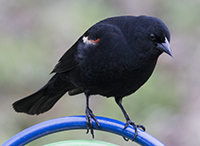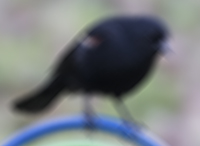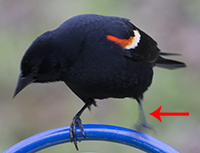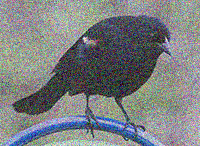This week’s mission: Making blur-related concepts clear.
Blur refers to the elements in the photo which do not have enough clarity to see details. It could be only one or multiple subjects in the photo, or it could be the entire photo. Blur can sometimes be intentional improving the photo, or can be unwanted and make an image unusable.
Blur in a photo can have multiple causes.
1) Blur can be caused by blurring out the foreground and background in a photo to make the main subject stand out more. In the example below, the bird is in focus, but the background is out-of-focus. This type of blur is usually controlled by using a different sensor size, focal length, or aperture. The quality of such blur is called bokeh, which we go in further details down below. When talking of the quantity of such out-of-focus blur, we usually talk about depth of field, which represents how much of the image is in focus.
2) A blur which is normally not wanted is caused by camera shake, where the whole image becomes blurry, and is usually unusable, except for some art forms where blur is intentional. Camera shake can be prevented by using a faster shutter speed, or using a camera or lens with some form of Image Stabilization, which can have different names depending on the manufacturer (Vibration Reduction, Vibration Compensation, etc). One rule of thumb to prevent camera shake blur is to use a shutter speed at least as fast as your focal length. So if you’re using a 300mm lens, your shutter speed should be at least 1/300s or faster. If you use Image Stabilization with 4 stops compensation on that same 300mm, you could use that same 300mm lens at around 1/(300/(2^4))s = 1/(300/16) = 1/18.75s instead of 1/300s.
3) A blur which can sometimes be used artistically is called movement blur, where an object going fast in front of the camera becomes blurry, with the foreground and background still sharp. You can do this artistically by using a slower shutter speed, or you can prevent it by using a faster shutter speed. Which shutter speeds to use mostly depends on how fast the object is moving, focal length, and how far it is from the camera.
4) Panning blur is where you have a fast moving object as in 3), but you pan the camera to follow the movement, so the object stays sharp, and the foreground and background instead become blurry.
5) While technically not blur, some noise can be caused by using a high ISO film or setting which makes the image unsharp, or by modifying the exposure value in post production by a large amount. We usually refer to it as a noisy image.
Bokeh is probably one of the most used catch phrases of Photography, but unfortunately it is rarely used correctly both gramatically and phonetically. The Japanese would pronounce the ‘eh’ like the ‘a’ in “a rock (as opposed to the ‘a’ in Ale). However it is oftenly incorrectly pronounced as rhyming with “O-Kay”.
Lets start by what isn’t bokeh to understand some key terms. If you look at a photo or video (which is basically a series of photos anyways), you may notice some blur coming from out-of-focus elements. A common mistake is calling that bokeh, for instance: “The 400mm f/2.8 lens produces a lot of bokeh.” A correct way of saying it would be “The 400mm f/2.8 lens causes a lot of foreground and background blur.” or “The 400mm f/2.8 lens causes a lot of the elements to be out of focus.”
As we saw, bokeh has nothing to do with the quantity of the blur. So what is bokeh? It has everything to do with the QUALITY of the blur. Lets say you have two lenses, a Canon 70-200mm f/2.8 and a Nikon 70-200mm f/2.8 You both extend them at 200mm, and you both select an aperture of 2.8. The images will look very similar, but one major difference could be the quality of the blur. While it wouldn’t change how much of the image is blurry, you might notice that one blur is more pleasant to the eyes than the other. THAT is what we call bokeh! So the correct use of bokeh would have “This lens offers very pleasant bokeh”. Bokeh is also very debatable, some people might prefer the bokeh of the Canon 70-200, while some prefer the bokeh of the Nikon 70-200.





